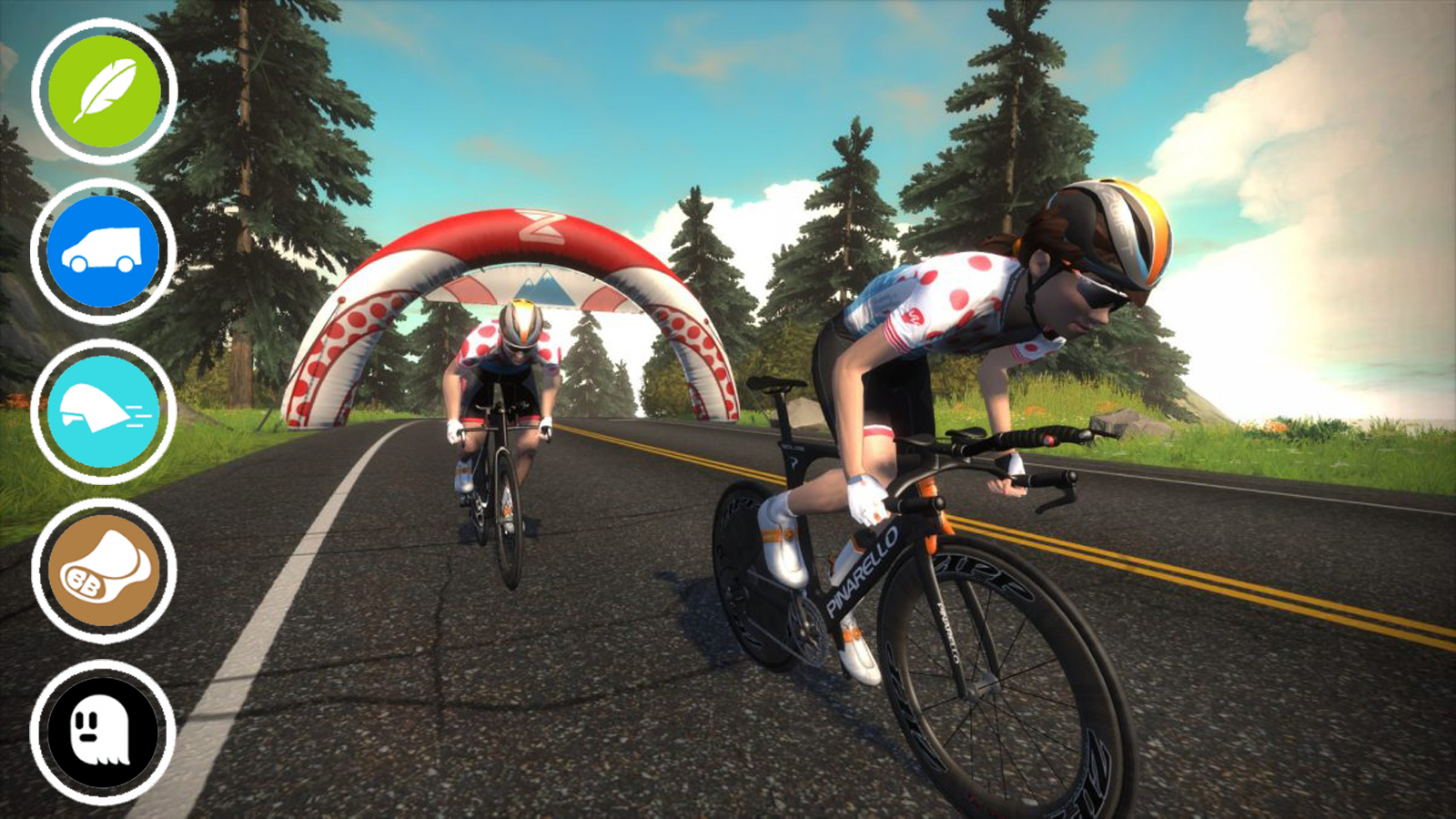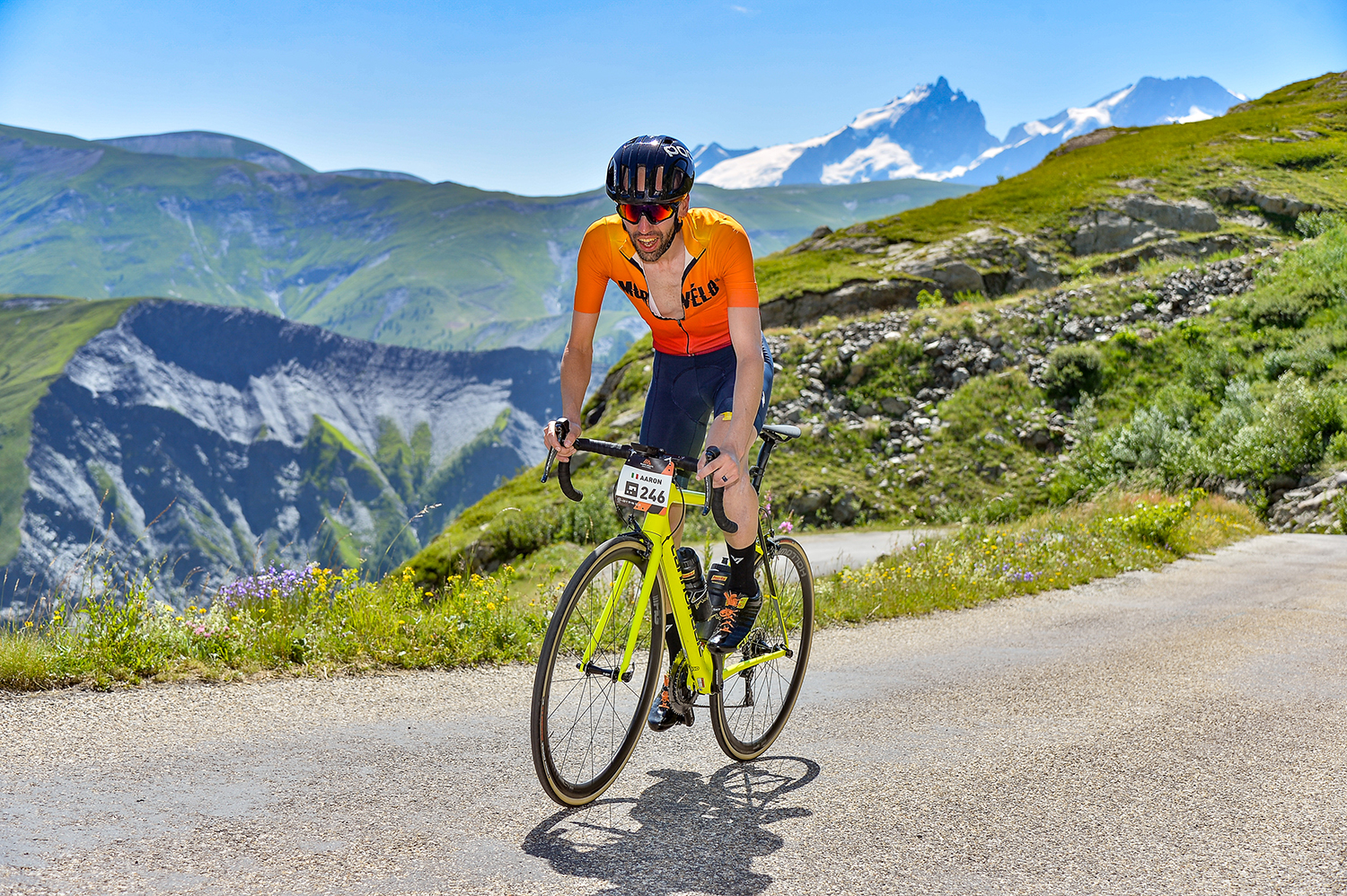Zwift PowerUps: What are they and when should you use them?
We take a closer look at the Zwift PowerUps and reveal how best to make them work for you

OK, so that global lockdown sold you on the indoor-cycling concept, but the whole Zwift thing has left you scratching your head. There's a lot to take in, isn't there? In this article, we'll look at Zwift PowerUps, explain exactly what they are, what they do, and provide tips on when is best to use them.
However, if you're looking for a more broad explanation of Zwift, we've already written a comprehensive Zwift guide to run you through the ins and outs of
the platform as well as to show you what you need to get started.
The more you use Zwift, the more XP (experience points) you will accumulate to unlock various gear options, components and bicycles – all of which have a direct bearing on your in-game performance. If these unlockables and virtual bicycles pique your interest, chances are you're the competitive type and will inevitably start experimenting with eRacing and the myriad race options on offer within the game.
If that's you, then you might be pleased to see we've put together a handy guide explaining how to race on Zwift too, where you'll not only find setup advice but top tips from inside the pixelated peloton. We also have a nice little explainer of ZwiftPower, which is somewhat of an unofficial governing body over Zwift racing and is the first place to go to check your post-race results and how you stack up.
It's in the Zwift racing world that you'll discover that FTP is just three letters, and that massive power numbers can only get you so far in the realm of pixels. Zwift is, after all, just a game, and possesses many novelties and hacks that you can use to boost your performance. These performance boosters are called powerups and are randomly awarded as you pass through a start/finish area or sprint arch, or summit a KOM.
There are seven different types comprising two XP bonus powerups (large, 250 points; small, 10 points), and five performance-enhancing powerups that can be used to your advantage in races – and here we'll be covering the latter.

1. Feather Lightweight (feather)
The Feather powerup reduces your weight by 9.5kg, making it ideal for launching an uphill attack or avoiding getting dropped on a tough climb. When to use it will come down to experience and strategy, as it lasts for just 15 seconds.
Get The Leadout Newsletter
The latest race content, interviews, features, reviews and expert buying guides, direct to your inbox!
Pro tip: You guessed it: the feather only really works on steep, steep climbs. Use it to your advantage on sections of road that point skywards.
2. Truck Draft Boost (van)
The Truck Draft Boost powerup is best used when tucked behind other riders in the bunch. It increases the effect of drafting by 50 per cent, so you can take a small rest while maintaining the same speed as those ahead of you. Again, a strategy is very important here. Some Zwifters will use it to launch an attack from the back to double-up on the drafting effect of the bunch – but be smart, as it only lasts 30 seconds. It can also be a great tool to close those final few metres when bridging to a break, or it can help get you back into the bunch if you're on the verge of being dropped.
Pro tip: The Truck Draft Boost only works when you're drafting somebody – it's useless if you're out solo or you've been dropped. Save it for the right moment.
3. Helmet Aero Boost (helmet)
Like the Truck Draft, the Helmet Aero powerup lasts for 30 seconds and is a sprinter's secret weapon. Not only is it handy for going on attacks off the front and bridging to the group ahead, should you experience a dead wheel, but it also helps for going faster on the descents. However, of all the benefits it provides, the Helmet Aero Boost powerup is ideally suited for contesting the sprint.
Pro tip: Use the helmet aero on fast downhills (it may catch out the bunch by surprise), for bridging to the breakaway or even when it comes down to the sprint.
- How to race on Zwift
- 10 hacks for indoor cycling
- Zwift eRacing nutrition tips: How to fuel for a bike race
- How to train to win a Zwift race
4. Breakaway Burrito
The Breakaway Burrito is another clever powerup that can be cunningly used at a pivotal point in the race – just before a climb or in the lead-up to the sprint finish. Essentially, what it does is make you undraftable for 10 seconds. Use it wisely, especially when rivals are sitting on your wheel and taking advantage of the draft.
Pro tip: As you activate the burrito, give a flurry of watts and dig deep for a few seconds to fully exploit its benefit.
5. Invisibility (ghost)
The Invisibility powerup is great for a sneaky breakaway attack thanks to the cloaking it provides for 10 seconds. Again, this can also work in your favour when contesting a sprint finish but can also be used to bluff your breakaway companions in certain situations.
Pro tip: Best used on specific courses with sharps corners and ups and downs. If used correctly, you just might get away – just don't hold up on the power.
6. Steamroller
The Steamroller reduces the CRR of your bike for 30 seconds. CRR stands for Coefficient of Rolling Resistance which is used to measure how quickly your tyres roll over a given terrain, and this Zwift PowerUp will mean that for 30 seconds, your tyres will roll as fast as road tyres on pavement, no matter your choice of equipment, or the terrain you find yourself on.
Therefore, it would prove fruitless to use the Steamroller whilst using your road bike on pavement already, however, if you find yourself in the cobbled sections of Crit City or racing your mountain bike on the off-road sections of the Jungle Circuit, you can make some serious gains.
In order of rolling speed, the Zwift surface types are listed as Pavement, Brick, Cobbles, Wood, Ice/Snow, Dirt, then Grass. With this in mind, if you're racing a mixed-surface course, wait until the slowest surface to launch your PowerUp.
Pro tip: In a road race, wait for the bridges or cobbled sections, as this is undoubtedly where you'll get the most bang for your buck.
OK, so that global lockdown sold you on the indoor-cycling concept, but the whole Zwift thing has left you scratching your head. There's a lot to take in, isn't there? In this article, we'll look at Zwift PowerUps, explain exactly what they are, what they do, and provide tips on when is best to use them.
However, if you're looking for a more broad explanation of Zwift, we've already written a comprehensive Zwift guide to run you through the ins and outs of
the platform as well as to show you what you need to get started.
The more you use Zwift, the more XP (experience points) you will accumulate to unlock various gear options, components and bicycles – all of which have a direct bearing on your in-game performance. If these unlockables and virtual bicycles pique your interest, chances are you're the competitive type and will inevitably start experimenting with eRacing and the myriad race options on offer within the game.
If that's you, then you might be pleased to see we've put together a handy guide explaining how to race on Zwift too, where you'll not only find setup advice but top tips from inside the pixelated peloton. We also have a nice little explainer of ZwiftPower, which is somewhat of an unofficial governing body over Zwift racing and is the first place to go to check your post-race results and how you stack up.
It's in the Zwift racing world that you'll discover that FTP is just three letters, and that massive power numbers can only get you so far in the realm of pixels. Zwift is, after all, just a game, and possesses many novelties and hacks that you can use to boost your performance. These performance boosters are called powerups and are randomly awarded as you pass through a start/finish area or sprint arch, or summit a KOM.
There are seven different types comprising two XP bonus powerups (large, 250 points; small, 10 points), and five performance-enhancing powerups that can be used to your advantage in races – and here we'll be covering the latter.

1. Feather Lightweight (feather)
The Feather powerup reduces your weight by 9.5kg, making it ideal for launching an uphill attack or avoiding getting dropped on a tough climb. When to use it will come down to experience and strategy, as it lasts for just 15 seconds.
Pro tip: You guessed it: the feather only really works on steep, steep climbs. Use it to your advantage on sections of road that point skywards.
2. Truck Draft Boost (van)
The Truck Draft Boost powerup is best used when tucked behind other riders in the bunch. It increases the effect of drafting by 50 per cent, so you can take a small rest while maintaining the same speed as those ahead of you. Again, a strategy is very important here. Some Zwifters will use it to launch an attack from the back to double-up on the drafting effect of the bunch – but be smart, as it only lasts 30 seconds. It can also be a great tool to close those final few metres when bridging to a break, or it can help get you back into the bunch if you're on the verge of being dropped.
Pro tip: The Truck Draft Boost only works when you're drafting somebody – it's useless if you're out solo or you've been dropped. Save it for the right moment.
3. Helmet Aero Boost (helmet)
Like the Truck Draft, the Helmet Aero powerup lasts for 30 seconds and is a sprinter's secret weapon. Not only is it handy for going on attacks off the front and bridging to the group ahead, should you experience a dead wheel, but it also helps for going faster on the descents. However, of all the benefits it provides, the Helmet Aero Boost powerup is ideally suited for contesting the sprint.
Pro tip: Use the helmet aero on fast downhills (it may catch out the bunch by surprise), for bridging to the breakaway or even when it comes down to the sprint.
- How to race on Zwift
- 10 hacks for indoor cycling
- Zwift eRacing nutrition tips: How to fuel for a bike race
- How to train to win a Zwift race
4. Breakaway Burrito
The Breakaway Burrito is another clever powerup that can be cunningly used at a pivotal point in the race – just before a climb or in the lead-up to the sprint finish. Essentially, what it does is make you undraftable for 10 seconds. Use it wisely, especially when rivals are sitting on your wheel and taking advantage of the draft.
Pro tip: As you activate the burrito, give a flurry of watts and dig deep for a few seconds to fully exploit its benefit.
5. Invisibility (ghost)
The Invisibility powerup is great for a sneaky breakaway attack thanks to the cloaking it provides for 10 seconds. Again, this can also work in your favour when contesting a sprint finish but can also be used to bluff your breakaway companions in certain situations.
Pro tip: Best used on specific courses with sharps corners and ups and downs. If used correctly, you just might get away – just don't hold up on the power.
6. Steamroller
The Steamroller reduces the CRR of your bike for 30 seconds. CRR stands for Coefficient of Rolling Resistance which is used to measure how quickly your tyres roll over a given terrain, and this Zwift PowerUp will mean that for 30 seconds, your tyres will roll as fast as road tyres on pavement, no matter your choice of equipment, or the terrain you find yourself on.
Therefore, it would prove fruitless to use the Steamroller whilst using your road bike on pavement already, however, if you find yourself in the cobbled sections of Crit City or racing your mountain bike on the off-road sections of the Jungle Circuit, you can make some serious gains.
In order of rolling speed, the Zwift surface types are listed as Pavement, Brick, Cobbles, Wood, Ice/Snow, Dirt, then Grass. With this in mind, if you're racing a mixed-surface course, wait until the slowest surface to launch your PowerUp.
Pro tip: In a road race, wait for the bridges or cobbled sections, as this is undoubtedly where you'll get the most bang for your buck.
Aaron was the Tech Editor Cyclingnews between July 2019 and June 2022. He was born and raised in South Africa, where he completed his BA honours at the University of Cape Town before embarking on a career in journalism. Throughout this career, Aaron has spent almost two decades writing about bikes, cars, and anything else with wheels. Prior to joining the Cyclingnews team, his experience spanned a stint as Gear & Digital editor of Bicycling magazine, as well as a time at TopCar as Associate Editor.
Now based in the UK's Surrey Hills, Aaron's life revolves around bikes. He's a competitive racer, Stravaholic, and Zwift enthusiast. He’s twice ridden the Cape Epic, completed the Haute Route Alps, and represented South Africa in the 2022 Zwift eSports World Championships.
Height: 175cm
Weight: 61.5kg
Rides: Cannondale SuperSlice Disc Di2 TT, Cannondale Supersix Evo Dura-Ace Rim, Cannondale Supersix Evo Ultegra Di2 Disc, Trek Procaliber 9.9 MTB
